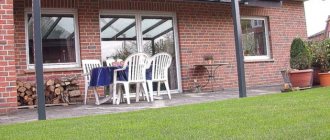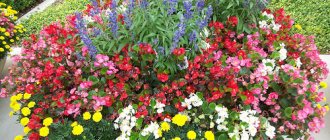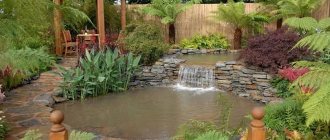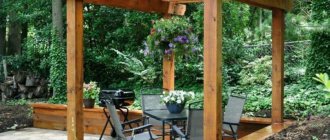Every owner of a garden plot or a private house wants to see his plot as a beautiful and well-groomed area. To achieve this, trees are planted in a certain way, artistic flower beds are laid out, and recreation areas are created.
Garden arches also play an important role in the design of the site.
Brief overview of the article
- Benefits of using arches
- Types of decorative arches
- Material manufacturing
- Types of accommodation
- Location
- Basic rules for creating arches
- Wooden arches
- Plastic arches
- Metal arches
- Stone arches
- Arch shapes
- Garden arch decoration
- DIY photo of a garden arch (pergola)
Benefits of using arches
Decorative elements can quickly and relatively inexpensively change the appearance of a site.
For any area, they can become charming transitions between zones, unusual decorations for paths, entrance areas or approaches to the porch.
In small areas, such decoration will allow for additional landscaping without taking away space from cucumbers, potatoes, and carrots.
Arches and pergolas entwined with flowers will add more color and greenery to the area, create a pleasant microclimate, and protect from bright sun rays or summer rain.
If the vines and vines have not yet managed to entwine garden arches, you can place hanging flower pots on them or use such structures for domestic purposes.
Construction stages
When choosing wood for future construction, you should pay attention to the quality of drying of the material. All consumables must be properly dried - this will eliminate the possibility of large shrinkage of the structure, and will also prevent the wood from rotting. It is better to give preference to larch species, such as oak, for example, or use pine and spruce.
After the area for the future construction has been selected and approved, it is necessary to dig holes about half a meter deep in the place of the proposed supports.
For the canopy, we use beams with a section of 100x100 mm as the main supports. Before installing them, the part that will be placed in the ground must be hermetically wrapped with roofing felt to protect the wood from rotting and damage by insects.
- Having installed and leveled the beams strictly, you need to pour concrete into the hole to strengthen the structure. Wait at least a day until it dries completely.
- After this, you can begin installing the cross beams, using them to connect the upper parts of the support pillars. The crossbars may extend slightly beyond the dimensions of the outlined perimeter.
- On them, in turn, planks with a section of 5x10 or 5x5 are laid, if the roof will not bear a large load.
Wood is an easy-to-process material, but requires protection from environmental influences. Therefore, the wood should be painted or varnished to protect it from rain and temperature changes.
The sides of the pergola can be sewn up with openwork strips to give the structure a more solid and respectable appearance. Or you can simply stretch the nylon threads so that the plant can comfortably climb up towards the sun.
Pergola decoration
Traditional options for “clothing” for a canopy have become grapes, actinidia, Chinese lemongrass and hops. Common bindweed and nasturtium look great. A chic option for a romantic mood and a unique aroma is a climbing rose.
A harmonious neighborhood is considered to be the presence of any bodies of water or decorative sculptural compositions nearby.
By placing a dining table in the gazebo-canopy, you can very comfortably relax in the cool shade of fragrant plants. The soothing sound of shimmering water nearby will put you in a calming mood and put any nervous system in order.
Types of accommodation
An arch for plants in the garden can be represented as a free-standing element. In this case, it plays the role of a vertical accent.
A group of arches will create a charming floral corridor that can unusually decorate a path or approaches to buildings.
A wall made of trellises will be a good design for fences or to limit the functional parts of a large area.
Pergola or gazebo
At the moment, almost every suburban area has a gazebo. Gazebos are considered very functional structures. They can be located a short distance from the house or adjacent to it, forming a kind of veranda or terrace.
Pergola-gazebo entwined with plants
Many people believe that a pergola is just a decorative arch. But that's not true. Pergolas can be either a free-standing decoration on a country plot, or they can be adjacent to the house and be large in size. What will be better used - a pergola or a gazebo? It all depends on the functional needs of these structures.
Wooden gazebo-pergola made of timber, attached to the house
Location
Photos of a garden arch will help you find the most optimal place to place a decorative element.
Most often, a large arch is located at the entrance to the site. It can be used instead of a traditional gate or precede it, inviting you to take advantage of the hospitality of the hosts.
Compositions of several arches are installed in front of the entrance to the garden or above the paths.
Separate trellises can be made into a hut, or a garden swing or bench can be charmingly hidden inside three trellises, and a small area of privacy and relaxation can be placed in such a closed corner.
Selecting the right varieties
Not every type of grape is suitable for creating a beautiful, well-formed arbor. We need frost-resistant, fast-growing, bulky varieties. The “Wild Maiden” grape is a favorite decorative variety among many summer residents. This is a great solution if you don't need berries. It is unpretentious, easy to care for and very beautiful. One plant can occupy an area of up to 20 square meters. It easily climbs without trellises along brick and stone masonry to a height of up to 15 meters. The oblong carved green leaves light up scarlet, crimson, and purple in the fall.
Of the fruit-bearing arbor species, actively growing Amur varieties are frost-resistant (withstand frosts down to -30 degrees). Fruits with a pronounced taste. Unpretentious in care, with strong development and pleasant taste, varieties are “Lydia”, “Valiant”, “Alpha”, “Concord”, “Isabella”. The bushes are undemanding to plenty of sun and tolerate shade well. Universal table varieties that produce a bountiful harvest have proven themselves to be excellent - Prairie Star, Victoria, St. Croix, Timur. They are frost-resistant, but in some regions they need shelter.
You will learn how to select and secure grapes for a gazebo in the next video.
Basic rules for creating arches
A low arch is not suitable for placement above paths. The standard height is considered to be a 2-meter structure; even a tall person can easily fit into such a passage, and the hanging branches will not catch anyone passing by.
It is advisable to make the width of the arch slightly larger than the path. Furry plants can significantly narrow the passage over time.
A garden arch should look attractive at any time, with or without plants. The manufacturing material must withstand rain, snow, wind, withstand the weight of plants, give the structure strength and be characterized by durability.
Trellis
Trellis are lattice structures that serve as vertical support for climbing plants. They can be made of metal or wood. As a rule, such structures are erected only for decorative purposes. They can be made free-standing or near the wall of a building in a suburban area. Trellis can be attached to the side walls of pergolas.
Wooden trellis
Wooden trellises are made from thin slats and framed with a wooden arch. This kind of arch does not have high strength. It is for this reason that you should not load such a structure with heavy plants - roses or grapes.
Summer cottage area decorated with trellises
Metal trellises are very durable structures. They can be made using elements of decorative forging. They look no worse than wooden trellises and perform similar functions. A pergola on a country plot is not only a decorative gardening structure on which plants climb. It can be large in size and used as a gazebo where the whole family can gather over a cup of tea.
Wooden arches
Wooden arches are still the most popular option for creating these options for decorating areas.
The advantages of using wood include a charming appearance, which is suitable for all design styles and even in the absence of them will give the site a nice look.
Wooden arches can be made quite inexpensively if you use leftover wood from building a house or barn. Lattice, willow, and branches will look good.
Eco-friendly wood does not heat up in hot weather and maintains a comfortable temperature for plants when it gets cold.
The only drawback will be the relative fragility of the wood. High-quality selection of components and the use of special impregnations will help increase the service life of a wooden arch.
Work process
Pergola design
Below is a step-by-step process for making your own wooden canopy:
1
The soil for construction on the territory is carefully leveled
2
Using wooden pegs, markings for the supports are marked, and the gaps between them are measured. The length between the supports on the long sides should be 1 m
3
When creating a kind of blinds for the transverse roof bars, wide boards are used, which are placed on the edge with the “west-east” direction. This arrangement will allow the sun's rays to illuminate the pergola from the inside in the morning and evening. During the daytime, darkness will be created in the structure
Place pipe stands and level using a level
4
Holes are dug under the supports, which should be at least 20 cm wider in width. Their depth depends on how tall and heavy the structure is, i.e. the higher the pergola, the deeper the recess for the supports
5
The base of the pit is leveled, compacted and filled with crushed stone approximately 10 cm
6
Support pillars are placed in a vertical position and concreted
For greater structural strength, metal glasses are used when installing supports. These are pipe cuttings. Their diameter should be larger. They are placed in pits in a vertical position and concreted on the outside. After the concrete has hardened, pillars are inserted here, temporarily strengthened, and the entire space is filled with concrete. When everything hardens, the temporary fastenings are removed.
7
Upon completion of work with the supports, the horizontal crossbars are assembled. Recesses are prepared in them, the size of which is equal to the support pillars. After assembling the posts with recesses, the horizontal crossbars should protrude 10 mm to create a protrusion
The distance from the sawn recesses to the edge of the horizontal crossbars and to the top of the support posts should be the same. To fasten the crossbars, through holes are made and bolts of the required size are used.
On racks, you can saw through recesses to a maximum of half their thickness, on crossbars - no more than 1/3. At the ends of the posts and crossbars, you can make inclined cuts or sharpen them. All parts are carefully processed and polished.
Concrete support base
8
Upon completion of work with horizontal crossbars, 2 arches are obtained. They need to be fastened. To do this, the roof boards are installed on edge. The gap between them should be approximately equal to twice the width of the board. Next, recesses are cut out (≈1/3 of the width of the board) and placed on the crossbars.
The edges of the boards are cut diagonally or decorated with curly cutouts. They should protrude equally on both sides. For fastening, self-tapping screws and nails are used, which are driven in diagonally.
When covering the roof with ceramic tiles in the future, it is necessary to choose strong rafters and frames so that they can withstand the weight of the ceramics. The tiles are laid at a slope (angle 40).
9
To complete the construction, cross boards are attached to the side posts at the top and bottom. Then install trellises or make a lattice. The installation distance of the crossbars from the top beams and the ground will depend on the size and shape of the trellis or trellis.
When installing the grille, for its vertical supports, it is necessary to prepare recesses in advance, or use bars (40x40 mm) and fasten them with self-tapping screws
The finished pergola must be painted or varnished. This will protect the tree from adverse environmental conditions.
How to make a children's house with your own hands: from wood and other materials. Drawings with dimensions | (80 Photo Ideas & Videos)
Plastic arches
Arches made of plastic will be the cheapest structure. You can buy them in a store or make them yourself from pipes. The bright design will immediately attract attention.
But plastic may not withstand frost, so the arch will have to be dismantled for the winter. Planting perennials near it will not be the best idea, and annuals will not be able to cover the entire structure. An unstable plastic arch will hardly withstand strong winds, and it will not suit every design style of the site.
Tips and tricks for using pergolas in landscape design
Experts advise following some recommendations for using pergolas:
It should be remembered that in winter all the flaws in the structures will be exposed, so the connection and fastening elements must be visually neat.
The choice of color is of great importance:
- brown - fits perfectly into the environment of weaving branches and flowing green foliage;
- white - will create some kind of airy illusion;
- variegated - it will simply be a bright spot against the general background of greenery.
When designing a pergola, you should take into account the strength with a margin, since the plants will grow, develop and their weight will increase. Also, the structure, braided with plants, is exposed to air currents and powerful gusts of wind.
Most of the options for making pergolas are associated with the use of natural wood texture
The light design of the pergola looks beautiful against the background of bright green trees, shrubs or climbing plants
If the pergola is made of a combination of metal and wood, it is logical to use different colors for each material
The closer the roof crossbars are located, the more shade you can get, but the plants will receive less light.
When installing structures along the walls of buildings, according to the instructions, you should maintain a distance so that the plants do not trail along the walls, especially on the south side, and do not subsequently die from overheating.
A garden pergola is a fashionable, stylish and effective element in the landscape of a garden, park or plot, which, if properly arranged, can become a comfortable and cozy place to relax for the whole family.
Metal arches
Garden arches made of metal will serve you happily ever after. Many structures already have additional protection against rust, so no special care is required. A metal arch will become a reliable support for any plants, it will withstand any weight, and rain, snow, and wind will not interfere with it.
But such an arch will be an expensive purchase. It will be quite difficult to do it yourself; for this you will need a welding machine and experience working with it.
In this case, you will have to attend to regular painting of the structure. In hot weather, the metal can become very hot, and in winter it can become very cold, causing certain inconvenience to the plants.
Metal pergola
The metal pergola is a rather interesting design. It can be made of metal pipes of different sizes and diameters. When designing a metal pergola, the dimensions of the structure play a very important role. The choice of material will depend on this. It will also be necessary to take into account the observance of proportions: the width of the pergola should be slightly larger than its height. You can make a rectangular metal pergola or a square shape.
It is better not to make high and narrow pergolas from metal. Such structures will be very unstable.
Metal pergola designs
Once the dimensions and plan are approved, you can proceed to manufacturing. To do this, metal pipes are cut to a specific size. You need to know that the support for a metal pergola must be larger in diameter than the connecting crossbars. As a rule, pipes with a cross section of 20x40 or 20x20 mm are used for such structures. The support can be 50x50 mm.
All elements of the metal pergola are connected to each other by welding. This design is highly durable.
You can make a stationary pergola from metal, or you can make it portable. A stationary metal pergola must be fixed to the ground or on a stand. To do this, very often a certain area in a suburban area is concreted to place a pergola on it. The load-bearing supports are attached to this site using metal screws and then welded to the fasteners of the entire structure. Such a pergola will withstand winds well and will last a very long time if used correctly.
Stationary metal pergola
Advice. A metal pergola requires regular maintenance and painting. All this is necessary for the reason that the metal corrodes and begins to deteriorate. To prevent this from happening, every season you need to apply several protective layers of paint or varnish to the surface of the structure.
A portable metal pergola can serve as a decoration in any part of a suburban area. It is easy to install and can even be dismantled, which will allow you to easily dismantle it and put it away for the winter. This design is lightweight and made of small diameter metal.
Metal portable pergola
A wrought iron pergola is one type of metal pergola. While a simple metal pergola may have a slightly rough appearance, a pergola with elements of decorative forging looks luxurious and elegant. If you can make an ordinary metal pergola with your own hands, it is impossible to build a forged one. To do this, you need to use special equipment and have knowledge and experience in the manufacture of forged decorative elements. You can't do this without practice. It is for this reason that wrought iron pergolas are easier to buy. The price for them is quite high, since the forging is made by hand and to individual order.
Wrought iron pergola
A metal pergola can be gable or have a rounded top. To do this, a small diameter pipe is rolled on a special machine. He gives it the required radius.
Advice. In order to make the top part of a metal pergola round, it is necessary to measure all the dimensions of the pipe, since while giving the pipe a radius, its size will decrease in length.
In order not to end up with supports for the upper part of the pergola that do not correspond to the established dimensions after rolling, the size of the pipe must be increased by 10-20 cm and only then subjected to changes.
In order to make a metal pergola with your own hands, you will need:
- Metal pipes of different diameters;
- Wire for welding and ordinary;
- Welding machine;
- Angle grinder;
- Stainless steel nails and screws;
- Hammer.
Stone arches
Arches made of brick or stone will last for a long time. They look very solid and stylish, and can be used even without floral decoration. Original arches can be made into perfectly straight shapes or you can slightly diversify the appearance of the site by building unusual structures.
However, it is better not to erect such structures in small areas, where they will take up a lot of space and will look very strange. Massive buildings will not suit some styles (Japanese, Provence) and will take up a lot of space. To create a stone arch you will need the skills of a mason.
Choice of colors
Creating a pergola in a country house or suburban area does not end with the construction of the main structure and its painting. Not all, but very many of these structures are initially, as planned, or subsequently decorated with flowers or other plants.
This could be a “hedge” or just individual flowers in decorative pots.
It is necessary to select plants for a pergola with the understanding that they will look different at different times of the year, spring, summer and autumn. Thus, the entire appearance of this gazebo canopy will change significantly, depending on the time of year.
So here are a few quick rules to keep in mind:
- There is no need to select too many types of plants (vines, flowers, etc.), as this will complicate their care.
- It is advisable to choose flowers with similar growth periods.
- It is best to choose perennials that are unpretentious and resistant to difficult growing conditions.
- It is advisable to cover those plants that do not tolerate winter well, or take care in advance to move them to a place more suitable for this time of year.
One of the classic climbing plants for a pergola is the virgin grape. It climbs well and quickly forms a kind of green “tent”, providing a pleasant rest. Landscape design experts recommend it, among other things, because in the autumn months it changes its color, becoming crimson-red. It looks very beautiful.
In addition to it, you can also plant wild or cultivated grapes (different varieties).
However, a pergola for grapes is not the only possible option. Honeysuckle, climbing roses or honeysuckle are also beautiful, low-maintenance plants for such canopies and arches.
On a note! The described types of structures can be used not only in your garden, but also for arranging summer cafes, restaurants and verandas.
As for clematis, they require slightly more care when compared with the plant examples given above. On the other hand, they look simply great.
Garden arch decoration
Plants become a traditional decoration of the arch. Beginner gardeners can start with annual or unpretentious perennial plantings. They can be nasturtium, sweet peas, morning glory, virgin grapes, ivy, climbing varieties of honeysuckle.
For those who already have experience in growing plants, you can plant more capricious clematis or climbing roses next to the arch.
For gardeners who are not ready to give up even small plots of land to create impractical beauty, they can take care of planting healthy Chinese lemongrass or grapes adapted to specific climatic conditions.
Photos of arches in the garden will help you choose the location, material and beautiful plantings that will turn an ordinary garden plot into a charming place.
Which climbing plants to choose?
A pergola is an arched structure that is often entwined with climbing plants of various types. With pergolas, the garden looks more impressive, especially if this arched structure is located along the path in the garden.
If you have a pergola in your garden, it, of course, needs to be decorated with suitable climbing plants, and we will now list some of them.
- Actinidia , or as this plant is also called, the northern sister of the kiwi, in all its diversity, Actinilea and ornamental grapes are also suitable for decorating a pergola.
- The pergola will look no less impressive if it is decorated with Maiden grapes or the beautiful honeysuckle, the latter, of which there are about one hundred and eighty species and subspecies.
- I would also like to note such plants as: Chinese lemongrass , which is stunning in its size; this plant reaches 15 meters in length. In addition, Chinese lemongrass is also a medicinal product, so decorating a pergola like this has double benefits.
- Another plant suitable for decorating a pergola is the hard-barked pumpkin . This plant is perfect if you want to create a secluded corner in your garden. In addition, the hard-barked pumpkin can protect from prying eyes; it grows decorative fruits that differ from each other. different colors, and the shape of the pumpkin leaf is very unique.
- In addition to perennial plants for the pergola, you can also decorate it with annuals, such as Dolichos lablab , which will also decorate the arched structure and, if desired, can be replaced next year.
In order not to disturb the structure of the landscape design, the pergola is most often not the main element of the garden; it acts as a small auxiliary extension. It is placed either somewhere in a corner or adjacent to the building.
Under the pergola you can build a barbecue or a small fireplace for outdoor cooking; it looks very beautiful and adds variety to everyday life. The pergola can also be equipped with various entertainment elements: swings, benches, a sofa, here you can fantasize for a long time.











